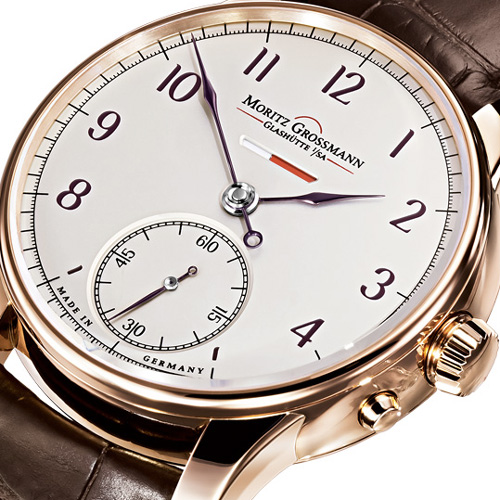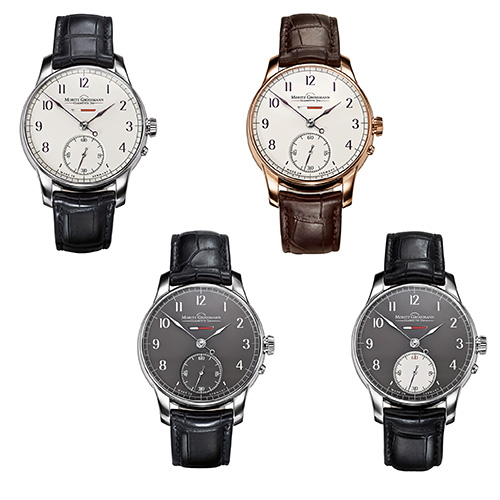
The Seconde Generation
The Moritz Grossmann manufacture presents the continuation of the BENU model line.
Since 2010, the name BENU has epitomised the revival of the MORITZ GROSSMANN GLASHUTTE 1/SA brand. As the young manufacture's first manually wound watch, the BENU embodies the horological passion of Moritz Grossmann, the elegance of his precision measuring instruments, and the conceptual aspirations of the watchmakers at Grossmann in the 21st century. Their ambition is to meld micromechanical ingenuity and traditional artisanship with latest-generation technology in the form of exclusive masterpieces of precision watchmaking.
Persistent renewal and improvement are part of the Grossmann heritage. The movement of the first BENU already incorporated genuine innovations. Now, in 2013, the BENU Power reserve stands out with four additional breakthroughs that refine user-friendliness and functional reliability.
- The novel power-reserve indicator emphasises the perfection of the secondgeneration BENU.
- The newly designed oscillator - the Grossmann balance- is crafted in-house in its entirety.
- The Grossmann winder with pusher features an enhanced handsetting mechanism.
- And the remodified Glashiitte stopwork supports the flexible arrangement of the parts.
While systematically evolved, the BENU Power reserve visually remains true to its model line. The narrow bezel of the slender, three-part case puts the focus on the face of a conspicuously inconspicuous watch. With its crisply defined minute scale, readily legible Arabic numerals, and the gracefuL sharp-tipped hands crafted in-house, the BENU evokes the aesthetic clarity of a 19th-century precision measuring instrument from Glashiitte. The redjwhite bar-shaped power-reserve indicator and the separate pusher adjacent to the crown are visible identifiers of the second generation.
The BENU Power reserve is being launched in four versions: Rose gold, white gold, and platinum with argente or grey dials. Special emphasis has been placed on the making of the hands. To achieve the best possible contrast against the grey dial, the shiny hands are crafted from stainless steel according to a proprietary process. Pockets in the hands are filled with a bright HyCeram compound. This material is dyed for UV stability and forms a permanent bond with the surrounding metal. The coloured filling can be ground flush with the hands and polished. As a result, the svelte, manually crafted Grossmann hands are especially brilliant and deliver precise readings of the time.
Calibre 100.2 movement
The calibre 100.2 movement of the BENU Power reserve is the familiar classic BEND-style pillar movement with a 2/3 plate, cantilevered balance cock, and the typical Grossmann micrometer screw. The BENU Power reserve unites the traditional characteristics of Grossmann-style horological prowess with modern watchmaking elements and the hallmarks of the new brand:
- Pillar movement with 2/3 plate and frame pillars in untreated German silver
- Hand-engraved 2/3 plate, balance cock, and escape-wheel cock
- Wide horizontal Glashtitte ribbing on the 2/3 plate
- Adjustment with Grossmann micrometer screw on a cantilevered balance cock
- Remodified Glashtitte stopwork with backlash
- Separately removable clutch winder
- White sapphire jewels in raised gold chatons with brown-violet pan-head screws
- 3-band snailing on the ratchet wheel
The power-reserve indicator
As was the case in Glashtitte observation watches, the BENU features a compactly designed crown-wheel differential train beneath the ratchet wheel. In this train, the rotary motion that occurs when the movement is wound or the mainspring unwinds is transferred to a carrier arbor with a planetary wheel. The display segment, one part white, the other red, is positioned above the hour wheel. A spring presses the hour wheel against its collar and the display segment against the dial; this stabilises both parts without affecting their rotation.
The specially designed bearing of the segment allows the power-reserve indicator to progress without affecting the movement, winder, or hour wheel. An aperture in the dial beneath the logo makes the display segment appear as a whitejred bar. When the mainspring is fully wound, the bar is white. The red portion gradually appears as the spring winds down.
The Grossmann balance
The newly designed oscillator had its debut in the calibre 100.1 movement. Optimised for artisanal manufacturing techniques, the ingenious design of the Grossmann balance improves the adjustability of inertia and achieves high kinetic energy combined with minimised air resistance and the smallest possible mass. The number of screws in the balance wheel rim was minimised, and the bores in the rim are equidistant. This makes it possible to vary the moment of inertia by inserting mass screws with different head lengths in the bores.
The smooth cylindrical balance staff is integrated in the hub and can easily be replaced if necessary. The Grossmann balance interacts with a Nivarox 1 balance spring which is overcoiled with a quarter arc on the inside and secured to the slotted roller with a brass pin.
The manual Grossmann winder with pusher
The watchmakers at Grossmann addressed the requirements imposed on a manually wound watch by focusing on improved convenience and greater functional reliability. The Grossmann winder with pusher features a refined handsetting mechanism that eliminates two possible error sources: the ingress of particles into the case while the hands are being set and the unintentional alteration of the hand positions while the crown is being pushed home again. When the user briefly pulls the winding crown out, this mechanism switches to the handsetting mode and stops the movement. The crown immediately returns to its home position but can be turned to precisely set the hands. Afterwards, the movement is restarted with the pusher adjacent to the winding crown without altering the positions of the hands. At the same time, this switches the mechanism back to the winding mode.
A modified Glashutte stopwork secures the tension of the mainspring. After winding, it allows the ratchet wheel to reverse somewhat and slightly relax the mainspring. Starting with the calibre 100.1 movement, Grossmann's watchmakers introduced an optimised, space saving variation of this recoil. The stop click sits on a lever that pivots about the centre of the mainspring barrel and accommodates the backlash stroke.







Movement Manufacture calibre 100.2, manually wound, adjusted in five positions
No. of parts 227
No. of Jewels 26 jewels, 3 of which in screwed gold chatons
Escapment Lever escapement
Oscillator Shock-absorbed Grossmann balance with 4 inertia and 2 poising screws, Nivarox 1 balance spring with No. 80 Breguet terminal curve, Gerstenberger geometry
Balance Diameter 14.2 mm, frequency 18,000 semi-oscillations per hour
Power reserve 42 hours when fully wound
Functions
- Hours and minutes, subsidiary seconds with stop seconds,
- Grossmann winder with pusher, power-reserve indicator
Special features
- Grossmann balance;
- lateral pusher for disabling the handsetting mode and starting the movement;
- bar-shaped power-reserve indicator with two-coloured display segment driven by a planetary gearing system;
- space saving and modified Glashtitte stopwork with backlash;
- adjustment with Grossmann micrometer screw on a cantilevered balance cock;
- Pillar movement with 2/3 plate and frame pillars in untreated German silver, 2/3 plate, balance cock and escape-wheel cock handengraved;
- broad horizontal Glashtitte ribbing, 3-band snailing on the ratchet wheel, raised gold chatons with pan-head screws;
- separately removable clutch winder;
- stop seconds for handsetting;
Operating elements Crown in 750/000 gold to wind the watch and set the time, pusher in 750/000 gold to start the movement
Case dimensions Diameter: 41.0 mm, height: 11.65 mm
Movement dimensions Diameter: 36.4 mm, height: 5.4 mm
Case Three-part, precious metal
Dial Solid silver, argente, with Arabic numerals
Hands Hand-craft ed, steel or stainless steel
Crystal/Display back Sapphire crystal, antirefle ct ion-coated on one side
Strap Hand-stit ched a lligator strap with butt erfly clasp in precious metal



